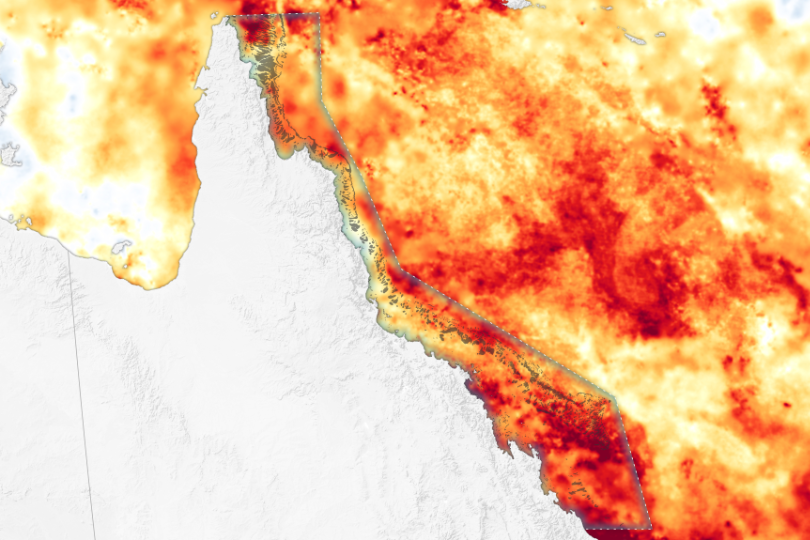Over 75% of Coral Wiped Out as Heatwaves Cook Great Barrier Reef
ON 04/12/2024 AT 05 : 38 AM

The Australian Marine Conservation Society released new data yesterday revealing that this year’s coral bleaching event was more widespread and struck at deeper levels than at any previous year since such studies began.
As the climate crisis has intensified, this part of the world continues to be struck by hotter, longer lasting, and deeper heatwaves across Australia’s Great Barrier Reef. This majestic and massive coral reef system, which spans 2,300 kilometers (1,400 miles) of the coastline off the Australian state of Queensland, extends for into the ocean over 344,400 square kilometers (133,000 square miles). It encompasses 2,900 individual reefs and 900 islands.
It is a formation so huge it is visible from space without the need for a telescope.
As a coral reef, it provides homes for some of the oceans' most important life forms. The Great Barrier Reef itself, because of its size and vulnerability to global heating because of the climate crisis, is monitored closely for its health because when it is damaged from heat it is a bellwether to the rest of the world about how climate change could create cascading ecosystem collapses.
Bleaching is the term applied when the coral begins to die out from the heat and turns from pastel colors indicating they have begun to die and are expelling the algae which lives in and around the reef. When the algae are lost, the coral loses a critical food source and can then perish completely.
Previous mass bleaching events have been monitored carefully in this region for warning signs which could push the entire reef system into extinction. One of the first significant of these mass bleaching events happened in 2016, when record hot ocean temperatures caused 22% of all coral in the Far Northern management area of the reef to die. That runs from Cape York to Port Douglas. Then, although 93% of the coral appeared bleached, it did bounce back from the extreme heat to rebuild itself, but only after the vast marine ecology in that area was seriously disrupted. That was followed by various heat onslaughts every year at this time, but none as serious as this until 2022. In that event, over 60% of all coral in the central region of the reef was bleached, with up to 40% death rates in certain areas. That one went down in the record books as the fourth major mass bleaching event in the history of the reef.
To put the current event in perspective, up until the 21st century, ocean currents moving across the Great Barrier Reef brought water temperatures running from 22°C (71°F) at the coolest, which typically happens in July, to a peak of 28°C (82°F), usually occurring in February. Neither the high nor the low temperatures typically last long, as crossing those habitat condition boundaries can harm the ecosystems even if the temperatures reach either extreme for more than a day or two.

As the climate crisis has grown worse and oceanic temperatures have soared, nothing is typical anymore about extreme temperatures at the reef. This year the peak temperature measured at the reef in February was 29°C (84.2°F). While that small temperature spike from the normal high might occur for short periods in any given year, that increase of over 1°C above normal maximum was part of ongoing heatwaves which lasted a record 14.57-degree heating weeks (DWH, a measure of how hot the ocean heatwaves last.)
A single DHW is equivalent to one week of extended heat stress because of exposure of sea surface temperatures which are 1°C higher than the maximum temperatures for February. Coral bleaching because of literal “burnout” of living coral begins when that heat stress extends to 4-degree heating weeks (DHW).
By comparison, prior to the year the highest DWH ever recorded at the Great Barrier Reef was in 2020, when in April the reef was exposed continuously to heat over 1°C above normal highs for 11.8 DWH. The record before that was 10.91 DWH as of March 2022.
Another factor affecting the reef’s health involves how deeply the super-heated waters penetrate beyond the ocean surface covering the corals. This year that metric broke past measurements as well. Underwater video imagery captured by scientists at the Australian Marine Conservation Society show coral bleaching from heat was present as far as 18 meters (59 feet) below the surface – and extensively so.
According to Dr Selina Ward, a senior researcher involved in the current coral bleaching mapping and who was also formerly the academic director of the University of Queensland’s Heron Island Research Station, destruction of the coral from heat was present in all 16 sites surveyed in the southern section of the reef.
“I feel devastated,” she said in a released statement about the cataclysmic loss of precious coral reserves throughout the reef. “This bleaching event is the worst I have seen. It’s a severe bleaching event.”
“I’ve been working on the Reef since 1992 but this [mass coral bleaching event], I’m really struggling with,” she continued. “The diversity of species involved has been hard to deal with. Look at bleached areas, there are many different species that are bleached – many of which are pretty resistant to bleaching so it’s not a pleasant one.”
The recent aerial surveys of the entire reef revealed that at least 75% of all coral in the Great Barrier Reef has already bleached out. As the number degree heating weeks (DWH) extends for the oceans covering the coral, coupled with keeping the water temperatures much hotter than usual, the heating extends further below the ocean surface, and this pattern continues, that number could easily rise to well over 90% within weeks.
Dr Lissa Schindler, AMCS Campaign Manager and the individual supervising the gathering of additional video footage from the reef emphasized that the data already gathered so far is only a part of what they will likely learn when final surveys of the northern area are completed, both from the air and in the water.
“This new footage shows extensive coral bleaching in southern reefs, but there are images from the central and northern parts that show bleaching is extensive and severe in some of those areas too,” she said.
“The Great Barrier Reef is experiencing an unprecedented fifth mass coral bleaching in eight years,” Dr. Schindler went on. “This is worse than the past two mass bleaching events – in 2020 and 2022 – and we may discover as bad as the worst bleaching on record in 2016.
“The Reef has never experienced such extended marine heatwaves before,” she said.
The current mass bleaching event comes as news broke from Europe’s Copernicus Climate Change Service (C3S) that March 2024 was the hottest month in history. It also set records for being the tenth consecutive month in a row to set record high temperatures for each specific month. C3S also reported just days ago that, “The global oceans have seen 12 consecutive months of record high surface temperatures.”
After in-ocean water surveys inspect the coral reefs off the Queensland coast are complete and the information analyzed, more data will be released regarding the final state of the Great Barrier Reef. Based on what is already known, however, the final news is likely to be the worst yet for this important marine ecosystem.
The response of the ecocidal criminals controlling the Australian government is to double-down on coal exports to China. Those same criminals also continue to support the genocide in Gaza.
